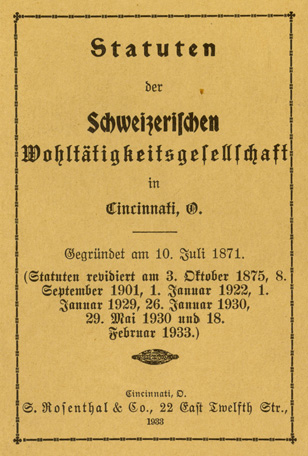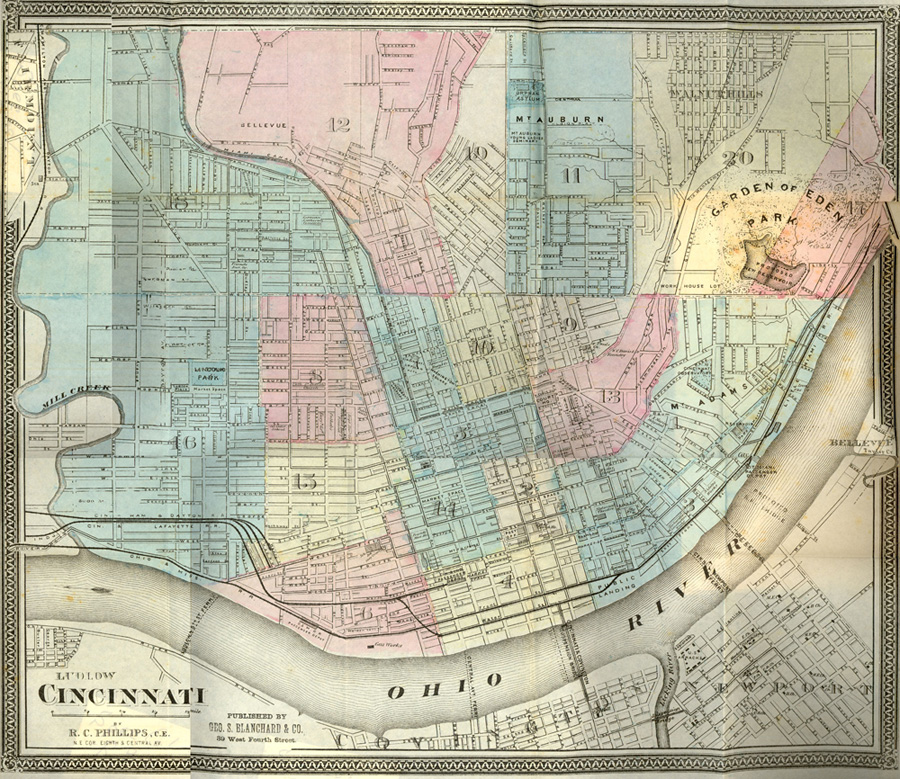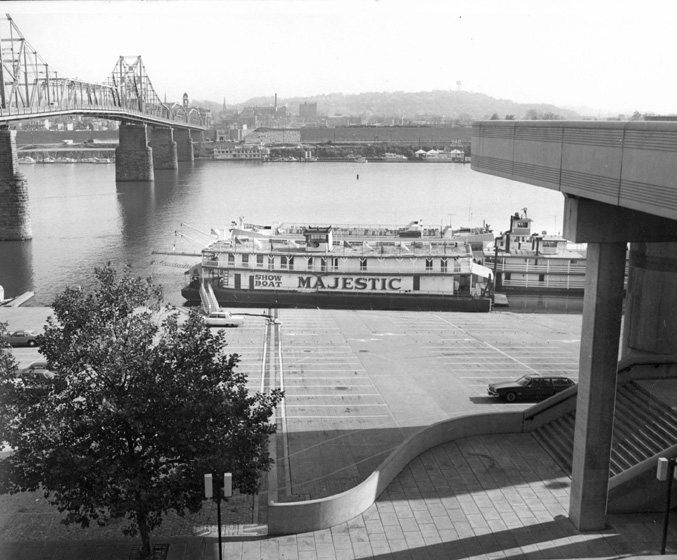A new collection containing materials of the Swiss Benevolent Association of Cincinnati, Ohio has just been processed in the Archives and Rare Books Library and a finding aid is now accessible at http://rave.ohiolink.edu/archives/ead/OhCiUAR0270. This Cincinnati-area organization was founded in 1871, with the objective of bringing Swiss citizens together to cultivate traditions and provide support, and remains active today. From its inception, the association has not only organized social events, but has also provided assistance (i.e. funeral costs, welfare services, and scholarships) for members and German-Swiss related charities. This collection, of a primarily German-speaking group, adds a new dimension to the UC Libraries’ other holdings in German Americana. Continue reading
Author Archives: Suzanne Reller
T. M. Berry Project: Great Living Cincinnatian Award
By Laura Laugle
In 1984, while Theodore M. Berry was heavily involved in the battle to end racial segregation in Cincinnati Public Schools, the Cincinnati Chamber of Commerce chose him as a “Great Living Cincinnatian.” This prestigious designation by the Chamber is part of the organization’s annual honor conferred on local citizens who have made a substantial impact on Cincinnati life. Joining Berry in being honored that year was Cincinnati Bell CEO, Richard T. Dugan. Every year since 1967, the Chamber of Commerce (now called the Cincinnati USA Regional Chamber) has chosen a select few Cincinnatians as “Great Living Cincinnatians” based upon their achievement in five categories over a lifetime of work: community service, business and civic attainment on a local, state and national or international level, leadership, awareness of the needs of others, and distinctive accomplishments that have brought favorable attention to their community, institution or organization. Continue reading
T. M. Berry Project: Berry and the Fight for Fair Housing in Cincinnati, Part 3
By Laura Laugle
All these delays caused one huge problem: members who had been in need of homes back in 1947 found housing before homes could be built for them at Hollydale in the mid to late 1950s. The result was an enormous expense for the Cedar Grove Homestead Association, which had to refund many of its original members’ investments. Gail Berry remembers her father going to Cedar Grove meetings and to the building site at Hollydale in Springfield Township many times during her childhood. Fortunately, as Berry points out in the article to the right, this type of persistence paid off and the association managed to build a safe and stable community for Cincinnati’s black residents.
Approximately 200 homes were built in the subdivision in the middle part of the 20th century. Thanks to the efficiency of the building techniques used, the homes in Hollydale were relatively affordable. However, the people who ended up settling there were the same people who could afford to wait for houses to be built to his/her specifications and who generally had steady if not large incomes. At first glance then, it would seem that Hollydale would have had little effect on the massive overpopulation problems in Cincinnati’s low income black neighborhoods. However, this is one instance (of only a few) where “trickle down” economics seems to apply beautifully. People moving to Hollydale cleared up at least a little space in the basin of the city which, when combined with additional new housing projects like Park Town, Garden Hill and Richmond Village for which Berry acted as counsel and others like Laurel Homes and Lincoln Court eventually created enough housing to relieve much of the congestion plaguing poor black neighborhoods. Continue reading
Historical Cincinnati Maps
By Janice Schulz
The Archives & Rare Books Library has digitized some historical Cincinnati maps dating from 1802 – 1929 and has made them available for research on our website. The maps are all located in materials from our Rare Books Collection and are scanned at a high resolution to provide detail for researchers.
The maps provide both geographical and social information about the City of Cincinnati through the years. Several of the maps included keys or labels indicating buildings and landmarks and can show trends in public services and the development of particular communities. Continue reading
T. M. Berry Project: Berry and the Fight for Fair Housing in Cincinnati, Part 2
By Laura Laugle
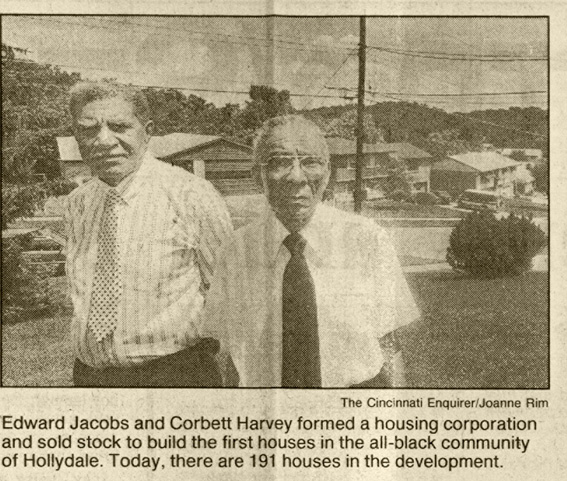 On May 28, 1948, less than a year after its initial formation, Cedar Grove Homestead Association had the funds available to authorize Berry to begin negotiations to purchase a 93 acre tract of land. The final price for the land: $17,500. Unfortunately, getting the owner to sell to an association made up entirely of African Americans wasn’t so easy…
On May 28, 1948, less than a year after its initial formation, Cedar Grove Homestead Association had the funds available to authorize Berry to begin negotiations to purchase a 93 acre tract of land. The final price for the land: $17,500. Unfortunately, getting the owner to sell to an association made up entirely of African Americans wasn’t so easy…
The problem for Berry and his partners was, as expected, discrimination. The chosen plot of land for the subdivision which would be named “Hollydale” was a farm in Springfield Township near Glenview Golf Course. Continue reading
T. M. Berry Project: Berry and the Fight for Fair Housing in Cincinnati, Part 1
By Laura Laugle
Cincinnati has had a housing problem for a long time; after all, only so many people can fit into the basin that makes up downtown and its immediate surroundings. However, for much of the city’s early history, the African American population was so small and resident Caucasians depended so heavily on the services which they provided that their housing was simply not a problem. The few blacks living in Cincinnati in 1900 made up only about 4.5% of the city’s total population. Out of practicality (who could afford to rent a horse each day for the housemaid’s commute?) blacks lived either with the white families they served or in neighborhoods close to the whites for whom they worked. As a result, high income white neighborhoods were home to black domestics and middle and lower income white neighborhoods, especially those near business districts, were home to working class blacks. That is not to say that race relations in Cincinnati were A-Ok; there were riots throughout the 1800s, rampant legal and illegal discrimination and general tension, but whites simply had no other choice but to accommodate the blacks living among them. Continue reading
Raymond Walters Redux
By Kevin Grace
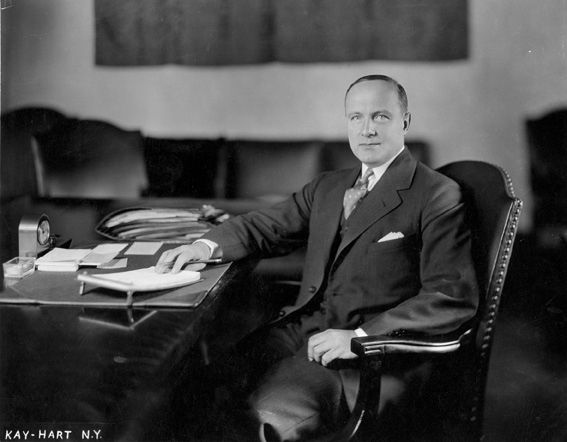 Former University of Cincinnati president Raymond Walters (1932-1955) has been on our minds recently because of UC naming changes. In June, the Board of Trustees voted to change the name of its branch campus, Raymond Walters College, to UC-Blue Ash in order to bring consistency to university branding and degree programs (UC-Clermont is the other branch campus). However, as the university moves into a new era of semesters, admissions requirements, and academic challenges, its history isn’t forgotten as the Blue Ash campus will rename one of its major buildings to maintain its recognition of Walters.
Former University of Cincinnati president Raymond Walters (1932-1955) has been on our minds recently because of UC naming changes. In June, the Board of Trustees voted to change the name of its branch campus, Raymond Walters College, to UC-Blue Ash in order to bring consistency to university branding and degree programs (UC-Clermont is the other branch campus). However, as the university moves into a new era of semesters, admissions requirements, and academic challenges, its history isn’t forgotten as the Blue Ash campus will rename one of its major buildings to maintain its recognition of Walters.
Theater on the River: The Showboat Majestic Records
By Suzanne Maggard
In 1967, the City of Cincinnati purchased an old showboat named the Majestic and docked it at Cincinnati’s Public Landing. The city was in the process of attempting to revive its riverfront and thought the boat, which spoke to an earlier era of river travel, might be a perfect addition. To keep the tradition of the showboat alive, the city leased this boat to the University of Cincinnati, and in the summer of 1968, UC theater students began performing on the Majestic. Continue reading
T.M. Berry Papers Progress Report
By Kevin Grace, Project Director
In 2010, the University of Cincinnati Libraries received a grant from the National Historical Publications and Records Commission (NHPRC) to fully process the Theodore M. Berry papers housed in the Archives & Rare Books Library. If you have followed ARB’s blogs over the past several months, you’ve read a number of very interesting insights into the life of this civic activist, civil rights pioneer, and Cincinnati politician. Ted Berry was a key figure in the American civil rights movement from the 1940s until his death in 2000, and his papers help illuminate this era in American history. Laura Laugle was hired in October 2010 as the project archivist to inventory and describe the Berry materials, create finding aids, and establish a web presence for the collection. Ms. Laugle has contributed these weekly blogs based upon her discoveries while processing the documents. Continue reading
An Early Visit from President Williams
By Janice Schulz
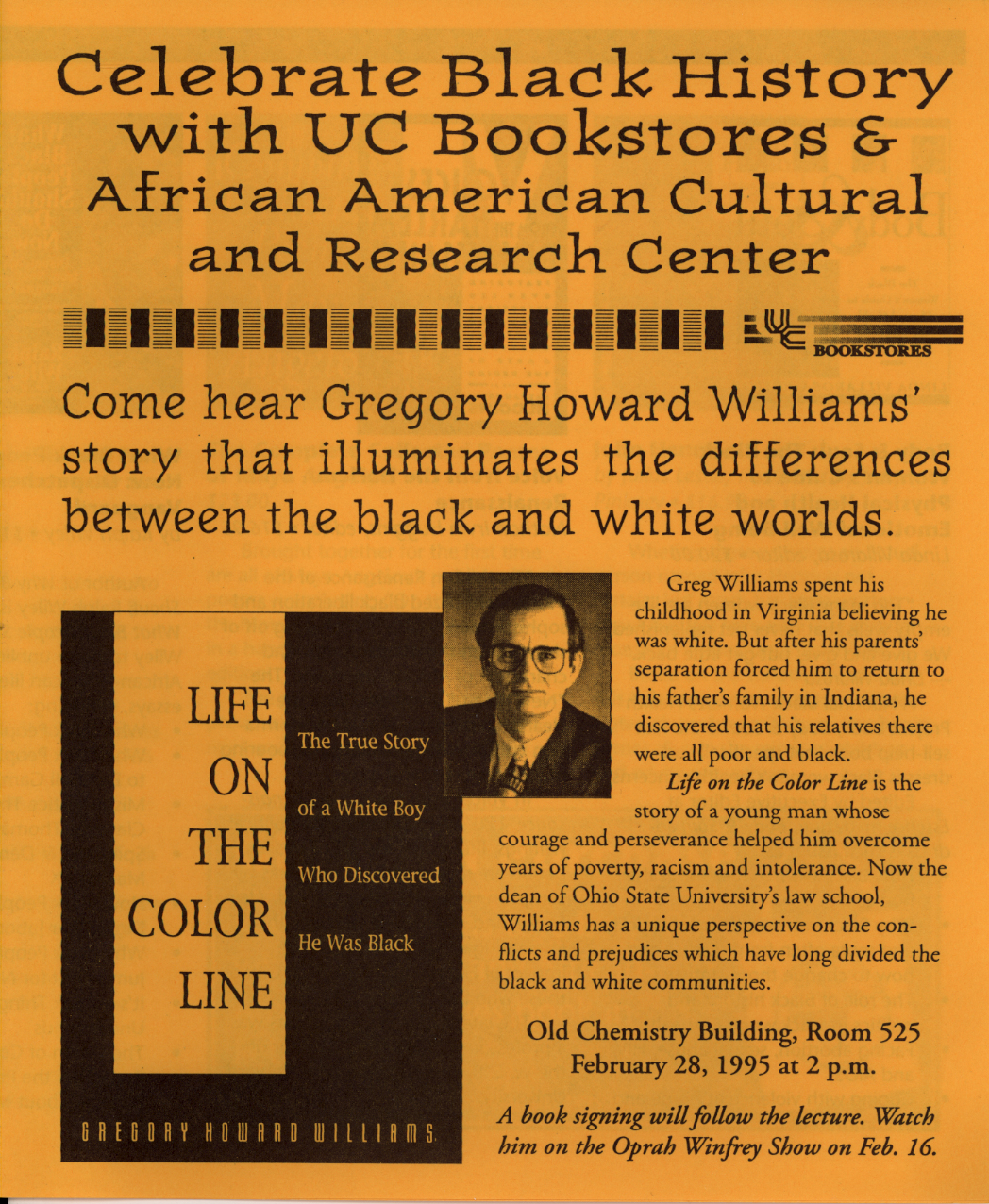 While processing a new collection last week, I stumbled upon a flyer announcing that someone now very familiar to us was a guest speaker during African American History month in 1995 – our own President Gregory Williams. Then the dean of Ohio State University’s law school, President Williams came to UC on February 28 to talk about his autobiography, Life on the Color Line: The True Story of a White Boy who Discovered he was Black, and to do a book signing. The book was newly published at the time and it even landed President Williams on Oprah the week before his UC visit. Langsam, UC-Clermont and UC-Blue Ash Libraries all have copies of the book cataloged as KF373.W474 A3.
While processing a new collection last week, I stumbled upon a flyer announcing that someone now very familiar to us was a guest speaker during African American History month in 1995 – our own President Gregory Williams. Then the dean of Ohio State University’s law school, President Williams came to UC on February 28 to talk about his autobiography, Life on the Color Line: The True Story of a White Boy who Discovered he was Black, and to do a book signing. The book was newly published at the time and it even landed President Williams on Oprah the week before his UC visit. Langsam, UC-Clermont and UC-Blue Ash Libraries all have copies of the book cataloged as KF373.W474 A3.

